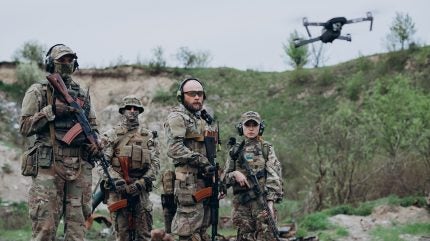
On Ukraine’s training grounds, extensive tests are being conducted to integrate ‘iron soldiers’, uncrewed systems such as reconnaissance drones, remotely controlled turret-mounted machine guns, sapper robots, and ground logistics robots, into the broader combat framework, according to a release from the Ministry of Defence of Ukraine on 17 July 2024.
Ukrainian Defence Minister Rustem Umerov is prioritising innovative projects to secure a strategic edge on the battlefield. This commitment has led to a significant acceleration and scaling up of such initiatives.
“The Minister of Defense and the Commander-in-Chief of the Armed Forces identified the development of robotic systems and their widespread use as one of the priority tasks,” said First Deputy Minister of Defense of Ukraine Lieutenant General Ivan Havryliuk.
According to the Main Directorate for Life Cycle Support of Armaments and Military Equipment, the Ministry of Defence has codified and approved more than 70 models of domestically produced uncrewed aerial systems (UAS) and nearly 30 ground robotic platforms for operation within the Armed Forces of Ukraine in the first half of 2024.
A notable project currently undergoing testing involves the combined use of ground and air robotic and uncrewed systems for specific combat missions. Experts involved in the project are optimistic about its imminent implementation in the near term.
The integration of uncrewed ground and air systems in military operations is rapidly evolving, with these systems now playing a crucial role in a range of duties including striking, reconnaissance, engineering, logistics, and evacuation.
“It is about systemic solutions and changes. The realities of war dictate new requirements. We must respond very quickly to the challenges of the times, always be one step ahead of the enemy, invest as much as possible in development of innovative tools of war in order to have more capabilities on the battlefield,” continued Havryliuk.
In May the Ukrainian Ministry of Defence (MoD) more than doubled the number of DJI Mavic drones it had acquired for use in operations against Russian forces, announcing on 21 May 2024, the purchase of a further 4,200 BPAK DJI Mavic 3E small UAS.
Lieutenant General Havryliuk underscored the significance of these developments: “We are observing the transformation of combat operations’ architecture due to the impact modern technologies. Our joint task is to provide our soldiers with as many modern types of weapons and military equipment as possible.
“The effective implementation of this project and its subsequent expansion will significantly contribute to the establishment of an advanced industry of robotic systems in Ukraine. And most importantly, it will save the lives of our soldiers on the front lines.”
Additional reporting from Richard Thomas.




